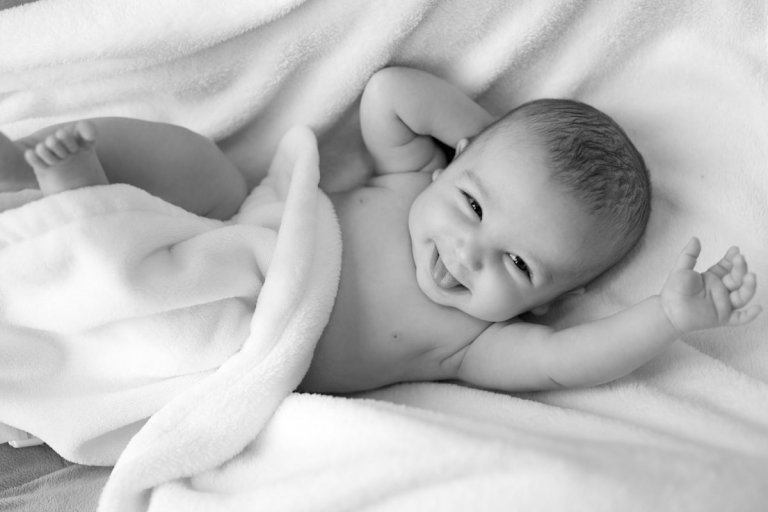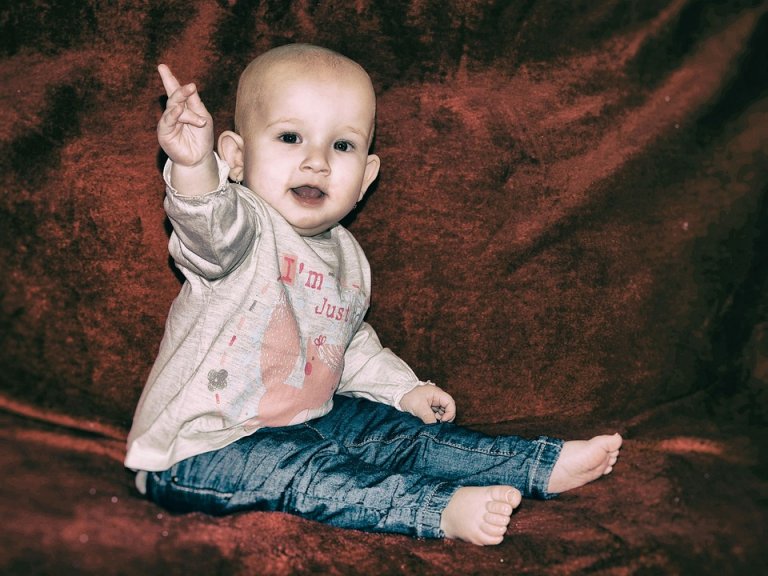Learning Your Baby's Sign Language

Many mothers struggle to understand their baby’s needs. However, it’s necessary to keep an open mind and pay attention to your baby’s sign language in order to understand that they have many ways of expressing themselves.
Especially when they cannot speak, children express themselves through their bodies. And when you have knowledge of these small gestures, you can immediately recognize what is happening to them or what your baby wants.
Crying is the most popular form of communication for babies, but not the only one. Babies also express themselves through body movements, smiles, gestures and sounds they emit to get your attention.
Usually, the baby’s signals will be more intense when directed toward the parents. With you, the cry will be stronger, but on the other hand you will also see his best smiles, especially when reuniting after the baby has been in the care of other people.
Babies’ language begins with gestures

All babies make gestures, show attitudes and make sounds so they can be understood. For example, when you are playing together, if he looks away, turns his head or arches his back, he is saying he needs to take a break and prefers to keep playing later.
Crying does not only mean that he is hungry. It can also mean feeling cold, wet or tired. Each baby has a way of crying to point out these discomforts and you will gradually identify them. Have patience to learn to recognize these small gestures.
Babies have several ways to show what they want. If your baby smiles while you are together, it shows that he feels good, comfortable and happy. You will find that discovering these baby signs will be very useful in establishing routines such as going to sleep and knowing when you need to help him fall asleep.
When your baby is close to 8 months old, you will probably notice that your child hangs on your neck and begins to cry when your friends or the pediatrician approaches. This indicates that he already knows how to distinguish between people he knows and doesn’t know, and strangers simply make him afraid.
Love for a newborn is simply one of the most beautiful things in the world.
-Author unknown-
With the passage of time, he will notice that they greet him amicably and will become accustomed to the idea, and eventually will accept them. But it takes time.
It is very important to keep in mind that the same signals can have different meanings in different babies. That is why learning to play with your baby sometimes requires time, dedication and patience.
Being able to respond correctly leads to a great deal of affection and will strengthen the bond. The key to this is to be very observant and have the patience to decipher your baby’s personal language.

Teach your baby sign language
It is important to always go at your baby’s pace and make sure he has fun. The ideal time to start is when your little one starts being interested in communication. You will notice that he becomes more sociable, begins to babble and makes sounds and expressions to attract your attention.
When you say a word, also make a sign or point to what you are naming. Always use the same sign, repeat it several times and emphasize the keyword as you make the sign so that your baby can see and clearly hear the connection between the two.
After a few days, your baby may begin to make the gesture alone, although it may take several weeks, so it is best to be patient. Make it fun for your baby. Your baby is more likely to learn if he enjoys what he is doing.
Some signs you can try
Different specialists recommend different groups of signs. The Sign With Your Baby program is based on American Sign Language; the Baby Signs program uses a set of simple signs designed especially for babies.
Either of these systems will work, just as a system invented by you would work. Any gesture that obviously imitates the meaning of the word will work well. Here are some examples:
- Food: place the tips of your fingers to your lips.
- It’s over/gone: raise your hands to the sides, palms facing up.
- Fear: pat your chest
- Hot: stretch your arm to touch something and then pick your arm up quickly
- Where is it? Shrug your shoulders, palms up
- Rabbit: wrinkle your nose and show two fingers
- Car: turn an imaginary steering wheel
- Book: put your hands together and then open them up, palms up.
Many mothers struggle to understand their baby’s needs. However, it’s necessary to keep an open mind and pay attention to your baby’s sign language in order to understand that they have many ways of expressing themselves.
Especially when they cannot speak, children express themselves through their bodies. And when you have knowledge of these small gestures, you can immediately recognize what is happening to them or what your baby wants.
Crying is the most popular form of communication for babies, but not the only one. Babies also express themselves through body movements, smiles, gestures and sounds they emit to get your attention.
Usually, the baby’s signals will be more intense when directed toward the parents. With you, the cry will be stronger, but on the other hand you will also see his best smiles, especially when reuniting after the baby has been in the care of other people.
Babies’ language begins with gestures

All babies make gestures, show attitudes and make sounds so they can be understood. For example, when you are playing together, if he looks away, turns his head or arches his back, he is saying he needs to take a break and prefers to keep playing later.
Crying does not only mean that he is hungry. It can also mean feeling cold, wet or tired. Each baby has a way of crying to point out these discomforts and you will gradually identify them. Have patience to learn to recognize these small gestures.
Babies have several ways to show what they want. If your baby smiles while you are together, it shows that he feels good, comfortable and happy. You will find that discovering these baby signs will be very useful in establishing routines such as going to sleep and knowing when you need to help him fall asleep.
When your baby is close to 8 months old, you will probably notice that your child hangs on your neck and begins to cry when your friends or the pediatrician approaches. This indicates that he already knows how to distinguish between people he knows and doesn’t know, and strangers simply make him afraid.
Love for a newborn is simply one of the most beautiful things in the world.
-Author unknown-
With the passage of time, he will notice that they greet him amicably and will become accustomed to the idea, and eventually will accept them. But it takes time.
It is very important to keep in mind that the same signals can have different meanings in different babies. That is why learning to play with your baby sometimes requires time, dedication and patience.
Being able to respond correctly leads to a great deal of affection and will strengthen the bond. The key to this is to be very observant and have the patience to decipher your baby’s personal language.

Teach your baby sign language
It is important to always go at your baby’s pace and make sure he has fun. The ideal time to start is when your little one starts being interested in communication. You will notice that he becomes more sociable, begins to babble and makes sounds and expressions to attract your attention.
When you say a word, also make a sign or point to what you are naming. Always use the same sign, repeat it several times and emphasize the keyword as you make the sign so that your baby can see and clearly hear the connection between the two.
After a few days, your baby may begin to make the gesture alone, although it may take several weeks, so it is best to be patient. Make it fun for your baby. Your baby is more likely to learn if he enjoys what he is doing.
Some signs you can try
Different specialists recommend different groups of signs. The Sign With Your Baby program is based on American Sign Language; the Baby Signs program uses a set of simple signs designed especially for babies.
Either of these systems will work, just as a system invented by you would work. Any gesture that obviously imitates the meaning of the word will work well. Here are some examples:
- Food: place the tips of your fingers to your lips.
- It’s over/gone: raise your hands to the sides, palms facing up.
- Fear: pat your chest
- Hot: stretch your arm to touch something and then pick your arm up quickly
- Where is it? Shrug your shoulders, palms up
- Rabbit: wrinkle your nose and show two fingers
- Car: turn an imaginary steering wheel
- Book: put your hands together and then open them up, palms up.
All cited sources were thoroughly reviewed by our team to ensure their quality, reliability, currency, and validity. The bibliography of this article was considered reliable and of academic or scientific accuracy.
- Farkas, C. (2007). Comunicación gestual en la infancia temprana: Una revisión de su desarrollo, relación con el lenguaje e implicancias de su intervención. Psykhe (Santiago), 16(2), 107-115. https://scielo.conicyt.cl/scielo.php?pid=S0718-22282007000200009&script=sci_arttext&tlng=e
- González Vargas, A. H. (2014). La adquisición del lenguaje y la gestualidad en la interacción adulto-bebé-objeto. http://148.206.79.158/handle/11191/5116
- Farkas, C. (2007). Desarrollo de la comunicación gestual intencionada en bebés: estudio de un caso. https://repositorio.uc.cl/xmlui/bitstream/handle/11534/28764/Desarrollo%20de%20la%20comunicación%20gestual%20intencionada%20en%20bebés-%20estudio%20de%20un%20caso.pdf?sequence=1
This text is provided for informational purposes only and does not replace consultation with a professional. If in doubt, consult your specialist.








